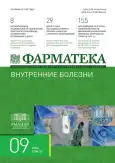Spleen damage in HIV infection, diagnostic and treatment issues
- Authors: Sundukov A.V.1, Puchkov S.S.2, Faller A.P.2, Svechnikova E.V.3,4
-
Affiliations:
- Russian University of Medicine
- Infectious Diseases Clinical Hospital No. 2
- Russian Biotechnological University of (ROSBIOTECH)
- Polyclinic No. 1 of the Administrative Directorate of the President of the Russian Federation
- Issue: Vol 31, No 9 (2024)
- Pages: 167-172
- Section: Коморбидность
- URL: https://journal-vniispk.ru/2073-4034/article/view/294184
- DOI: https://doi.org/10.18565/pharmateca.2024.9.167-172
- ID: 294184
Cite item
Abstract
Background. Spleen enlargement (splenomegaly) occurs in many infectious diseases and is a response of the mononuclear phagocyte system to the introduction and proliferation of various infectious disease pathogens. HIV-infected patients form a special group with spleen damage. In the Russian Federation, this problem remains unstudied to date.
Objective. Evaluation of the features of clinical, serological, immunological and instrumental methods of examination in HIV-infected patients with splenic infarctions and abscesses.
Methods. The main study group included 34 HIV-infected patients aged 23 to 46 years diagnosed with splenic abscess or infarction. The HIV infection stage 3 (subclinical) was detected in 3 (8.8%) patients, 4A – in 10 (29.5%), 4B – in 10 (29.5%) cases and stage 4С – in 11 (32.2%) patients. Intravenous drug use was detected in 24 patients. Bacterial endocarditis was determined in 16 (47.1%) patients, chronic hepatitis C – in 29 (85.3%), tuberculosis was diagnosed in 8 (23.6%) cases. The period of residence from the moment of HIV infection diagnosis ranged from 3 months to 18 years. Four (11.8%) patients were continuously taking antiretroviral therapy (ART).
Results. Surgical treatment for splenic abscesses was performed in 30 patients who were in hospital from 1 to 57 days, an average of 9.0±4.6 days, 4 (13.3%) patients died. In 4 cases, splenic infarction was diagnosed, the patients were treated conservatively and were discharged in a satisfactory condition. Most often, complications developed in patients with HIV infection stages 4B–4C, not taking ART, with a high viral load and low immune status, drug addicts, with various gastrointestinal tract (GIT) disorders and chronic viral hepatitis C. When examining HIV-infected patients with complaints of abdominal pain and hyperthermia, it is necessary to exclude gastrointestinal diseases, clarify the duration of HIV infection, adherence to ART and perform an ultrasound examination and/or computed tomography of the abdominal organs as soon as possible. The obtained surgical material must be sent for histological examination to clarify the causes of spleen damage.
Conclusion. Severe complications and fatal outcomes were more common in patients with HIV infection stages 4B–4C, not taking ART, with a high viral load and reduced immune status. Preference should be given to the laparotomy method of surgical intervention. All surgical material should be subjected to histological examination. After splenectomy, all patients should be prescribed ART.
Keywords
Full Text
##article.viewOnOriginalSite##About the authors
A. V. Sundukov
Russian University of Medicine
Author for correspondence.
Email: sundukov1961@mail.ru
ORCID iD: 0009-0008-2304-9743
Dr. Sci. (Med.), Professor, Department of Infectious Diseases and Epidemiology
Russian Federation, MoscowS. S. Puchkov
Infectious Diseases Clinical Hospital No. 2
Email: sundukov1961@mail.ru
ORCID iD: 0000-0001-8025-9386
Russian Federation, Moscow
A. P. Faller
Infectious Diseases Clinical Hospital No. 2
Email: sundukov1961@mail.ru
Russian Federation, Moscow
E. V. Svechnikova
Russian Biotechnological University of (ROSBIOTECH); Polyclinic No. 1 of the Administrative Directorate of the President of the Russian Federation
Email: sundukov1961@mail.ru
ORCID iD: 0000-0002-5885-4872
Russian Federation, Moscow; Moscow
References
- Ooi L., Leong S.S. Splenic Abscesses from 1987 to1995. The American J Surg. 1997;174:87–93. doi: 10.1016/S0002-9610(97)00030-5.
- Lee W.-S., Choi S.T., Kim K.K. Splenic Abscess: A Single Institution Study and Review of the Literature. Yonsei Med J. 2011;52(2):288–92. doi: 10.3349/ymj.2011.52.2.288.
- Liu K.Y., Shyr Y.M., Su C.H., et al. Splenic abscess a changing trend in treatment. South African J Surg. 2000;38(3):55–7.
- Davido B., Dihn A., Rouveix E., et al. Salomon. Splenic abscesses: From diagnosis to therapy. La Revue Med Interne. 2017;38(9):614–6. doi: 10.1016/j.revmed.2016.12.025.
- Tiri B., Saraca L.M., Luciano E., et al. Splenic tuberculosis in a patient with newly diagnosed advanced HIV infection. ID Cases. 2016;6:20–2. doi: 10.1016/j.idcr.2016.08.008.
- Dhibar D.P., Chhabria B.A., Gupta N., Varma S.C. Isolated Splenic Cold Abscesses in an Immunocompetent Individual. Oman Med J. .2018;33(4):352–5. doi: 10.5001/omj.2018.64.
- Sarr M.G., Zuidema G.D. Splenic abscess-presentation, diagnosis, and treatment. Surgery. 1982;92(3):480–5.
- Gerzof S.G., Johnson W.C., Robbins A.H. Nabseth D.C. Expanded criteria for percutaneous abscess drainage. Arch Surg. Chicago. 1985;120(2):227–32. doi: 10.1001/archsurg.1985.01390260085012.
- Lerner R.M., Spatario R.F. Splenic abscess: percutaneous drainage. Radiology. 1984;153(3):643–5. doi: 10.1148/radiology.153.3.6494461.
- Paris S., Weiss S.M., Ayers W.H., Clarke L.E. Splenic abscess. The American Surgeon. 1994;60(5):358–61.
- Gadacz T.R. Splenic abscess. World J Surg. 1985;9(3):410–5. doi: 10.1007/bf01655275.
- Alonso Cohen M.A., Galera M.J., Ruiz M., et al. Splenic abscess. World J Surg. 1990;14:513–6. doi: 10.1007/bf01658678.
- Herman P., Oliveiera e Silva A., Chaib E., et al. Splenic abscess. Br J Surg. 1995;82(3):335. doi: 10.1002/bjs.1800820323.
- Phillips G.S, Radosevich M.D., Lipsett P.A. Splenic abscess: another look at an old disease. Arch Surg. 1997;132(12):1331–6. doi: 10.1001/archsurg.1997.01430360077014.
Supplementary files





















